Dominique White
Interview by Ellie Barrett
-
Published December 2018
-
Critical art theory has never really grappled with materials in any way which is satisfying or useful to artists. By contrast, artists themselves seem to be urgently taking up material-led approachers for numerous reasons. As a result, we are faced with a worrying rift between what artists are doing and how this is actually reported both historically and in contemporary practice. This needs to be addressed in art writing. As a practicing sculptor currently undertaking a PhD research project into materiality, I have been visiting artists in their studios, making efforts to bridge this rift by examining the multiplicity of material uses in sculptural practice. I visited Dominique White’s studio as part of this research.
-
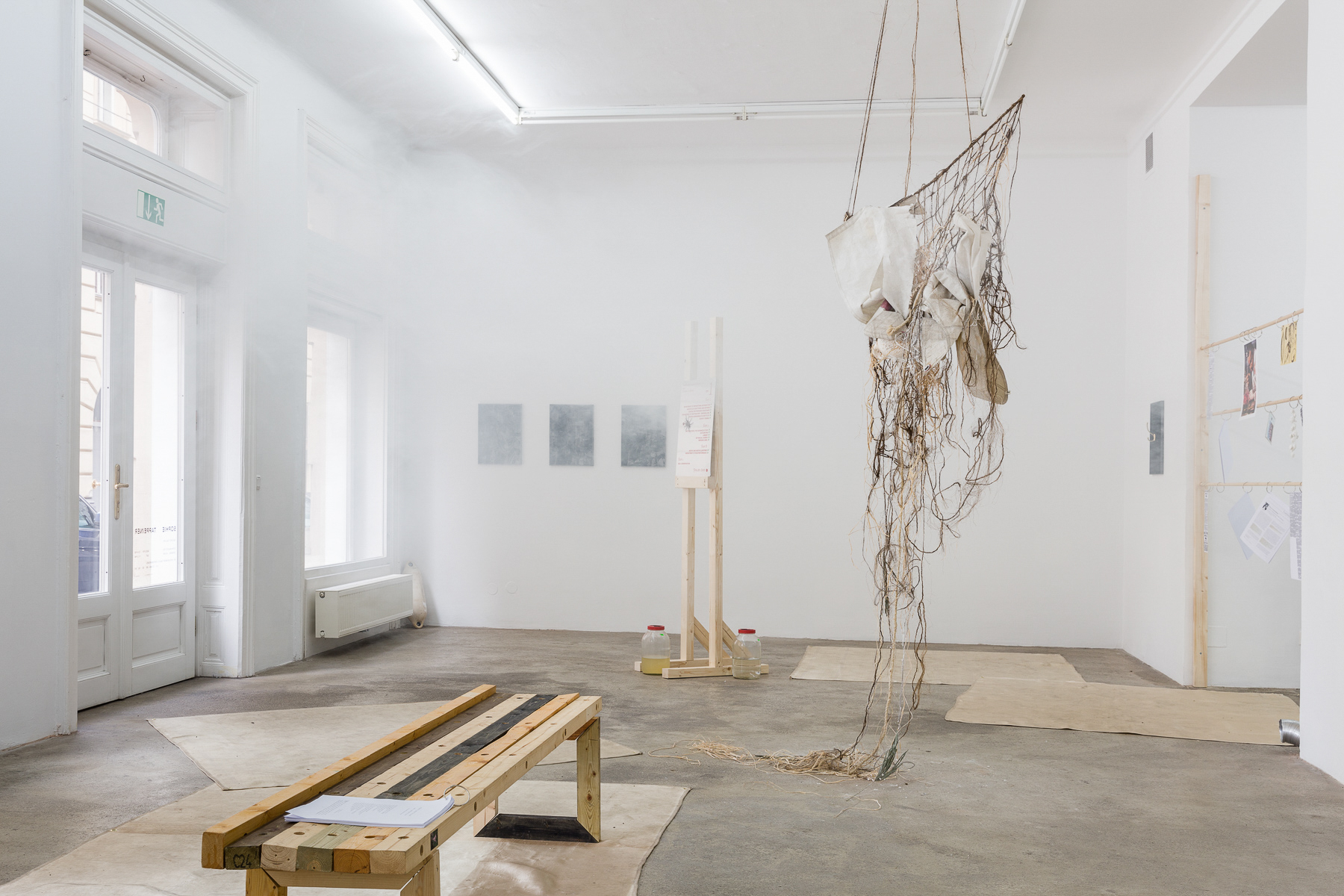
Landlocked Prisoner (2018) [hanging right] commissioned for The Share of Opulence; Doubled; Fractional at Sophie Tappeiner 14.09.18 - 03.11.19
Pictured with Patrick Staff & Candice Lin, Olu Ogunnaike and Kobby Adi. Courtesy the artist and Sophie Tappeiner.
Copyright: Kunstdokumentation.com)
To start by giving a context, can you talk about what you’re doing with your work overall?
I emulate shipwrecks: I’m very interested in nautical myths and old world politics. Everything looks like a dystopian relic of a civilization that has either existed or doesn’t quite sit in linear time. My works appear partially destroyed, but that is also because of the very specific materials that I use, such as palm fronds which will eventually decay. Or even just certain sail rope: the way that I manipulate it means it’s very delicate yet strong at the same time. I’m very interested in afro-pessimism and accelerationism from a black perspective. So, I think the easiest way of describing it is Blackness both being the destructor and inheritor of a new World. Instead of this new World being Mars or specifically in outer space, as in Sun Ra’s notions of Black futurity, I’ve situated it in the sea as some sort of abstract future in a tangible space.
And then how is this achieved specifically through the materials that you work with?
I work with a lot of found objects and materials. I work with sails; I source very specific ones that are highly worn and patched up. I also use nautical buoys, and materials that are almost stereotypically other. So whether that’s palm fronds or shells, or things that are associated with Black civilizations.

So you’re definitely choosing materials that have a loaded history?
Oh yeah. Even down to the rope that I use. Sisal rope, for example, is actually tarred. When it gets slightly heated from being handled, it leaves this black residue over everything that it touches. It’s a very odd material that I came across this year but now I love using it. Even down to its wispyness - that’s from me manipulating it and unpicking it.
So not only are you searching for materials that are historically and culturally loaded, but materials that allow you to perform a certain process?
Also that aren’t necessarily obvious processes for the materials. Because even the casting process and the clay I’m working with, casting this single buoy is literally going to take about a month. I have to fill the mould in layers and each layer takes so long, because it’s such a volatile clay to use.
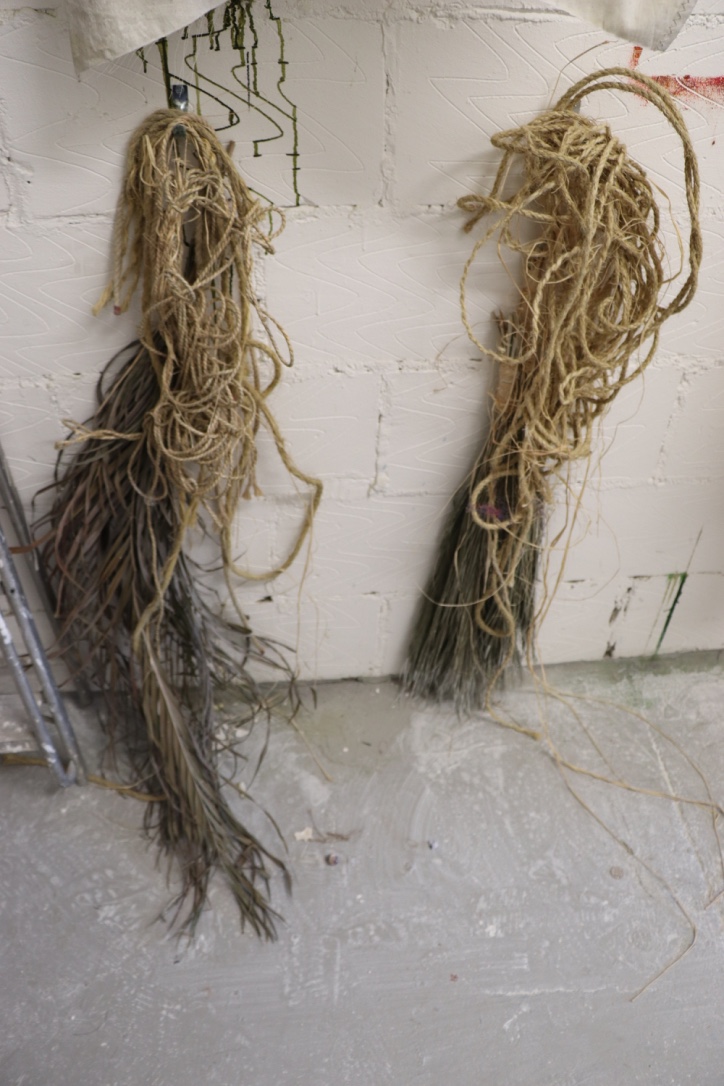
So is this the same clay that you were using when you showed work with GRAFT in 2017?
Yeah - kaolin - It’s the same I use with everything. I want to push the boundaries of this clay. You’ve seen me use it as a paint, and it wasn’t until earlier this year that I realised it can completely solidify, but it has to be under really certain conditions. I tried casting a full buoy in one go but it just would not set.
Do you have a sustained engagement with one material, or are they selected as appropriate to projects?
I usually play with a particular vocabulary of materials which develops over time. I also move onto other materials, for example I don’t really use that kind of really manufactured rope anymore. The rope that I use now is more loaded with histories instead of using a perfectly manufactured material which is primed for its use. I do continue to use raffia because I know what it can do. It’s weirdly strong, it can soak up water, so that’s why I use it in casting as a filler. Because kaolin is such a liquid clay it won’t set (within a day) unless you layer it with other materials. But then it does create this weird texture at the same time.
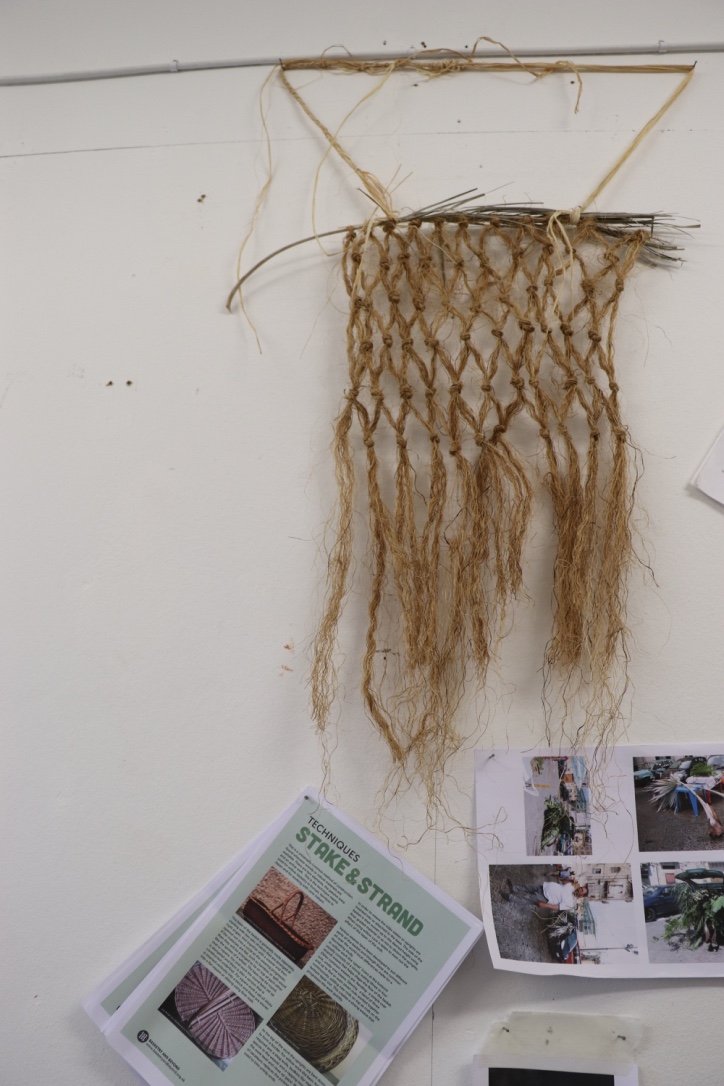
It seems like when you’re selecting materials, they do have these two aspects that are so woven together in that everything you’re choosing is coming as a product of your research, but also the things that they just really pragmatically allow you to do and the qualities that they have. So, is that a fair thing to say?
Yeah, yeah that is fair. I do actually like pushing those materials to the limits.
To what extent would you say that your work is materials led? And by that I mean would you say that you make the materials work for you, or is it more of a collaborative relationship, a negotiation or a feeling out of something where they push back against what you want them to do?
I think a bit of both. With some materials, it’s me in charge. But with stuff like kaolin, that’s me experimenting and realising actually, I can’t make a completely solid mass using this approach. There has to be a compromise. I feel like it’s more me in charge of the materials as opposed to a collaboration a lot of the time. I don’t know whether it’s the way that I handle it or force it to work. It just does.
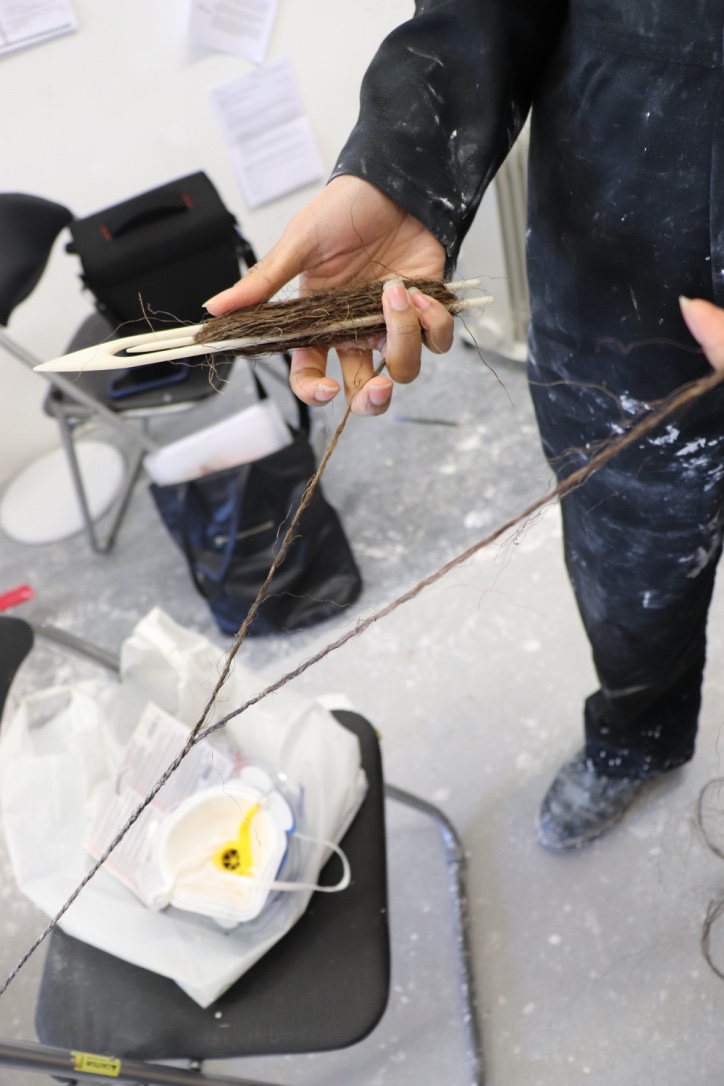
Can you speak about how you interact with them when you’re making and the kind of processes you go through when you’re figuring out what they can do? Maybe it’s interesting to talk about the kaolin, because last time I saw you, you were painting with it and now you’re casting these really big objects. There’s some kind of finding out or experimenting process in there that’s edging from one step to the next: how did you discover the qualities that it had that allowed you to do this?
Most of the time I discover stuff almost by working other processes into the ground. It actually cast solid in the bottom of a bucket and I managed to get it out and it was this beautiful solid disc. But then it has those qualities and it kind of crumbles under weight. That’s how I guess I treat most things materials: asking how much force can it take? How much can I load it with? So with kaolin, I ask much water or other materials can I mix with it before it just completely loses those qualities. Everything’s time based.
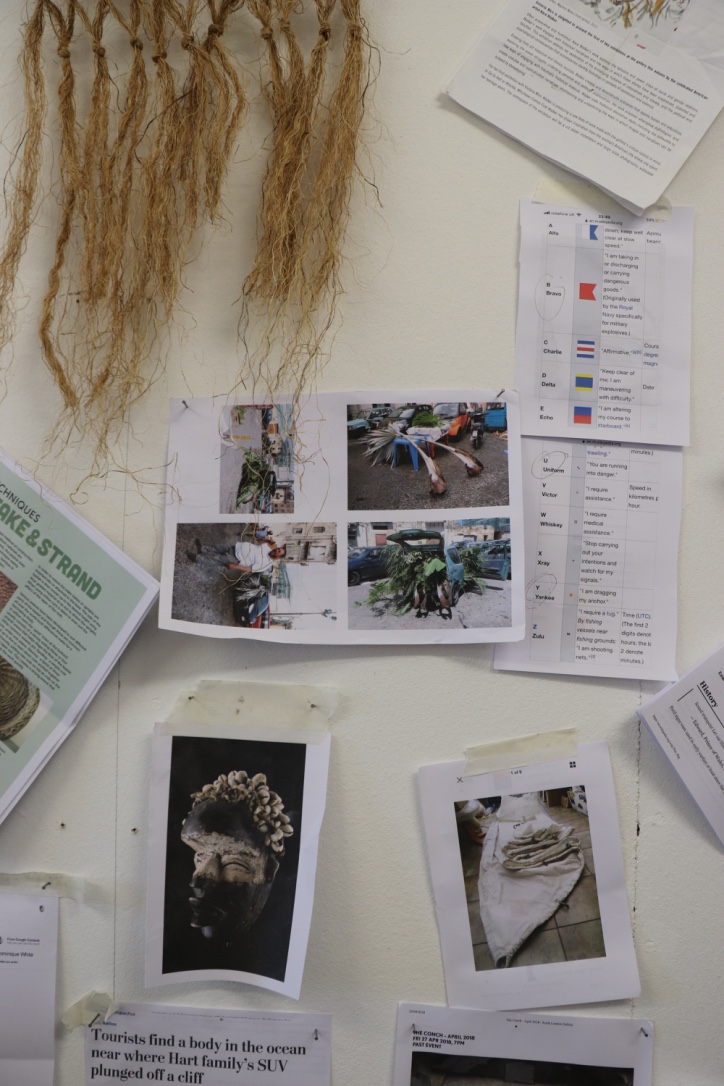
Are you very reactive to what they do?
Yeah. That’s how I also treat my work. I like to protect it when it’s in my studio and in transit but when it’s there it has its own narrative. The work that I had with you [GRAFT] sustained so much damage from being out in the rain and in the mud that I probably can’t show it again but that’s fine. I think that also ties in to people’s attitudes towards preserving art works as this monetary object.
There’s an ethical question amongst object makers about producing more stuff to go in the world, and artists seem to be thinking if I’m using stuff that’s already here then I’m not really making these giant things that have to be stored and looked after.
Yeah I have a weird relationship with preserving works. It’s also particularly in the history of institutions preserving black artist’s work against their will, either after they’ve died or they’ve preserved it or repaired it in a way that shouldn’t have happened. Or it’s even shown in a way that people don’t get to experience the whole thing. For example, I had no idea that Chris Ofili’s work that’s in Tate Britain - “No Woman No Cry” - glows in the dark. When you turn the lights off it turns bright green and it’s says “Stephen Lawrence, 1974 to 1993”. I never knew that. But that’s the way Tate show it. It’s a weird ownership of materials. I feel like I make work so the materials retain their autonomy. They can decay on their own terms. You can’t really repair a lot of them without completely changing the work.
Can you talk a bit more about the research that you’ve done to find your materials and the decision to pick them up and start making with them?
Some of them are by accident. So, kaolin, that I came across about five or six years ago in one of those really gross anthropological books from the ‘50s. It’s a naturally occurring clay that is often the (culturally loaded) white substance found on a lot of sculpture from central and western Africa. You can get it in skincare and other health related tools. I was actually painting my face at the time, but then over the years it’s developed away from performance-based approach to a sculptural approach. In terms of rope, I always use stuff that you would find on boats or nautical related objects. Tarred sisal is just the newest edition. Rope is sometimes very sterile and clean, whereas this is literally tar covered. It’s very specific to the nautical realm.
So do you find you have a particular attachment to materials that get you mucky when you touch them, or leave a trace or transfer onto bodies? Even if it’s a rope that you wouldn’t expect that quality from?
Yeah. I hate making sterile work. I also like the idea of removing that power dynamic from the viewer. Even looking at my studio floor now, it’s been mopped about six times but it still has the remnants of clay. When you walk on it, you also carry it away with you. That’s what I mean about this weird power play between art and the institution - art is elevated to this level for the viewer. So what happens when art is almost attacking the viewer through materials? That’s why I’m so interested in works decaying at an unknown rate.

And I suppose there’s something about using materials that allow it to break out of that elevated level and by getting stuff mucky? Or the way that you allow it to dissolve into the audience a bit? There’s always a feeling of transference going on?
Even down to how I hang stuff in space. An example being this large mooring cleat that I used to attach a work to the ceiling as opposed to using something like a little gold hook or chicken wire. This would be bolted into the ceiling using specialised anchor bolts - it’s a very solid object. But then again, that is very nautical - it’s used for mooring. I’m interested in the whole piece being considered part of the piece, if that makes sense. It doesn’t stop with the objects, it stops with how it’s hung or if it’s attached to the wall etc. It’s this fine line between it being an alien nautical object or relic from this lost civilisation and an art object. I’m really interested in this object that I found it on ebay. So it’s a kind of buoy that’s made completely out of rope. And it’s really bizarre because I’ve never seen them look like that. But it’s massive. It’s three or four foot tall. It also it looks like some kind of weird ritual object, like you’re supposed to set it on fire or something. But it’s just for boats. Apparently it’s quite a normal thing - I don’t know whether rope is just cheaper, or they last longer if they’re made this way. I’ve no idea.
Maybe it’s something to do with material that was immediately around. Do you think there is a current need for material focused sculptural practice?
Yes. I’m very bored of highly conceptual works that are super inaccessible to folks without a certain specialised knowledge. And that weird specialised language and education that you have to have even to have an entry point. So I guess that’s why I like to have a heavily material based practice because if you’re not from an art/philosophical background you can still take something from it. I have beef with inaccessible work. It’s very unnecessary I think.
One of the intrinsic things about material is that it can boil down to the simplest thing which is your physical interaction with the world around you. This can only happen with material engagement, so there needs to be an acknowledgement of that. They are a way of communicating things instantaneously. How do you feel, then, about how materials are discussed in art criticism? And how is your work discussed, do you think?
In reviews, it’s always discussed in a surface surface level way. I read lots of reviews that talk about my work as if the material is a symbol for something else entirely. Which is ok, but I feel like some critics are literally missing the nautical references.
Because there is not any discussion about the nautical things or the histories of the material that are so obviously there? Do you think there’s something to do with materials being perceived as being dumb? And if you’re sat around talking about the actual material qualities instead of getting up towards the metaphysical things that they’re doing then there’s a fear of looking stupid?
I think that, and also I think critics do forget that some artists do give a shit about the literal connotations of materials. I think sometimes art is so focused on stuff that appears to be something else, that the actual material is completely disregarded. For example, if an artist is using black paint, a critic might suggest that it appears to be oil. They’re actually not considering why the artist would be using black paint and not actually oil.
We’re so used to seeing symbols in art that people try too hard to see symbols through material.
Instead of looking at the literal decision making. Definitely. That’s why I’ve talked quite a lot about the futurity of my most recent work. When I showed Landlocked Prisoner, people were asking why I chose that title. And I said well, because it’s dry, it’s on land and if I submerged it in water it would completely dissolve and the piece would be...free. And people often do not think of how specific a particular material is and how specific decisions could have a different future in the work. If I put that work in a very moist environment it would very slowly just fall apart. The moment you introduce even a tiny bit of moisture, it’ll get soft. It’ll just break up.
I want to pick up on the way art seems to have a deadening effect on material, or the material sometimes is just disappears into the work and that’s the way that it’s also talked about or received. And it really feels like in your work you’re absolutely not letting that happen.
It’s really about there being a fine line between an art object and like some sort of other object that we can’t really understand. So this could be actually just plucked out the sea and you’ve just put it in a gallery, or has it just been made by an artist? And we don’t really know which one it is.
-
Dominique White (Essex UK, 1993) is a London based artist who merges incompatible worlds into a universe using a visual vocabulary which draws from blaccelerationism, afro-pessimism and beliefs surrounding the Kalunga; a watery boundary between the living and the dead. Her work takes form as sculptures, performances and installations which act as beacons of a fictional and experimental universe that only emerges into this realm bit by bit.
Recent exhibitions and talks include: Flood-tide at Love Unlimted (Glasgow, GB. 2018), The Share of Opulence; Doubled; Fractional at Sophie Tappeiner (Vienna, AUT. 2018), The Conch (April) at South London Gallery (London, UK. 2018) and Signs | Beacons (Manchester, GB. 2018), Dominique was also artist-in-residence as part of the Formerly Called network at Wysing Arts Centre throughout 2018.
-
blackdominique.com
-
If you like this why not read our interview with Richard Hughes
-
© 2013 - 2018 YAC | Young Artists in Conversation ALL RIGHTS RESERVED
